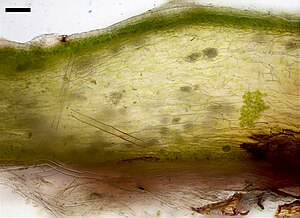Marchantiales
| Marchantiales | |
|---|---|

| |
| Conocephalum conicum - a thallose liverwort | |
| Scientific classification | |
| Kingdom: | Plantae |
| Division: | Marchantiophyta |
| Class: | Marchantiopsida |
| Subclass: | Marchantiidae |
| Order: | Marchantiales Limpr., 1877[1] |
| Families | |
|
See Classification | |
Marchantiales is an order of thallose liverworts that includes species like Marchantia polymorpha, a widespread plant often found beside rivers, and Lunularia cruciata, a common and often troublesome weed in moist, temperate gardens and greenhouses.
As in other bryophytes, the gametophyte generation is dominant, with the sporophyte existing as a short-lived part of the life cycle, dependent upon the gametophyte.
The genus Marchantia is often used to typify the order, although there are also many species of Asterella and species of the genus Riccia are more numerous. The majority of genera are characterized by the presence of (a) special stalked vertical branches called archegoniophores or carocephala, and (b) sterile cells celled elaters inside the sporangium.
Phylogeny
Based on the work by Villarreal et al. 2015[2]
Classification
Taxonomy based on work by Söderström et al. 2016[3] and synonyms from Collection of genus-group names in a systematic arrangement.[4]
- Marchantiaceae Lindley 1836
- Bucegia Radian 1903 [Radiania Györffy 1927]
- Preissia Corda 1829 [Achiton Corda 1829]
- Marchantia Linnaeus 1753 [Chlamidium Corda 1828; Marchantiopsis Gao & Chang 1982 non Douin & Douin 1918]
- Aytoniaceae Cavers 1911 [Rebouliaceae; Grimaldiaceae]
- Cryptomitrium Austin ex Underwood 1884 [Platycoaspis Lindberg 1889]
- Mannia Corda 1829 nom. cons. [Grimaldia Raddi 1818 non Schrank 1805; Cyathophora Gray 1821 non Michelin 1843; Neesiella Schiffner 1893b; Duvalia Nees 1818 non Haworth 1812 non Bonpland 1813; Neesia Leman 1825 non Sprengel 1818; Arnelliella Massalongo 1914; Sindonisce Corda 1829]
- Reboulia Raddi 1818 nom. cons.
- Plagiochasma Lehmann & Lindenberg 1832 nom. cons. non Pomel 1883 [Aytonia Forster & Forster 1775; Ruppina Linnaeus; Rupinia (sic) Corda 1829]
- Asterella Palisot De Beauvisage 1805 [Fimbraria Nees 1820 non Fimbriaria Stackhouse 1809; Asterella section Wallichianae Long 2014; Hypenantron Corda 1829; Octokepos Griffith 1849]
- Cleveaceae Cavers 1911 [Sauteriaceae]
- Aitchisoniella Kashyap 1914
- Clevea Lindberg 1868 [Gollaniella Stephani 1905]
- Peltolepis Lindberg 1876
- Athalamia Falconer 1848
- Sauteria Nees 1838 [Sauchia Kashyap 1916]
- Monosoleniaceae Inoue 1966
- Monosolenium Griffith 1849 [Dumortieropsis Horikawa 1934]
- Conocephalaceae Müller ex Grolle 1972
- Conocephalum Hill 1773 nom. cons. [Conicephala (sic) Wiggers 1780; Conocephalus (sic) Necker ex Dumortier 1822 non Blume 1825 non Thunberg 1815; Anthoconum Palisot De Beauvois 1804; Fegatella Raddi 1818; Hepatica Adanson 1763 non Miller 1754; Hepaticella Leman 1821; Strozzius Gray 1821; Nemoursia Merat 1840; Sandea Lindberg 1884; Conocephalum (Sandea) (Lindberg 1884) Inoue 1976]
- Targioniaceae Dumortier 1829
- Targionia Linnaeus 1753 non non Hesse 1923
- Wiesnerellaceae Inoue 1976
- Wiesnerella Schiffner 1896
- Dumortieraceae Long 2006
- Dumortiera Nees 1824
- Monocleaceae Frank 1877
- Monoclea Hooker 1820
- Oxymitraceae Müller ex Grolle 1972
- Oxymitra Bischoff ex Lindenberg 1829 non (Blume) Hooker & Thomson 1855 [Pycnoscenus Lindberg 1863 ; Tessellina Dumortier 1874 non Dumortier 1822]
- Ricciaceae Reichenbach 1828
- Ricciocarpos Corda 1829 [Euriccia Lacouture 1905; Lichenoides Lindley 1847 non Hoffmann 1789 non Barrande 1846; Lemna Rafinesque 1817 non Linnaeus 1753]
- Riccia Linnaeus 1753 [Hemiseuma (Bischoff) von Klinggraeff 1858; Riccia section Hemiseuma Bischoff; Hemiseumata Bischoff Lindley 1847; Riccia (Pteroriccia) (Schuster 1984) Schuster 1985; Pteroriccia Schuster 1984; Thallocarpus Lindberg 1874a; Cryptocarpus Austin 1869 non Kunth 1817 non Dozy & Molk. ex Dozy & Molk. 1846; Angiocarpus Trevisan 1877; Ricciella Braun 1821; Riccinia Trabut 1916]
- Corsiniaceae Engler 1892 [incl. Exormothecaceae Müller ex Grolle 1972]
- Corsinia Raddi 1818 [Guentheria Leman 1821 non Sprengel 1826; Tessellina Dumortier 1822 non Dumortier 1874; Brissocarpus Lindenberg 1829]
- Cronisia Berkeley 1857 [Carringtonia Lindberg 1868; Funicularia Trevisan 1877; Boschia Montagne 1856 non Korthals 1844; Myriorrhynchus Lindberg 1884]
- Stephensoniella Kashyap 1914 non Cernosvitov 1934 non Lastochkin 1935
- Exormotheca Mitten 1870 [Corbierella Douin & Trabut 1919]
- Cyathodiaceae Stotler & Crandall-Stotler 2000
- Cyathodium Kunze ex Lehmann 1834 [Synhymenium Griffith 1849; Synymenium (sic) Hagen 1910; Cyathodium (Metacyathodium) Srivastava & Dixit 1996]
References
- ^ Limpricht, G. (1877 "1876"). "Lebermoose". In Cohn, F. (ed.). Kryptogamen-Flora von Schlesien. Vol. 1. pp. 225–352.
{{cite book}}: Check date values in:|year=(help)CS1 maint: year (link) - ^ Villarreal; et al. (2015). "Divergence times and the evolution of morphological complexity in an early land plant lineage (Marchantiopsida) with a slow molecular rate". New Phytologist. 209 (4): 1734–46. doi:10.1111/nph.13716. PMID 26505145.
- ^ Söderström; et al. (2016). "World checklist of hornworts and liverworts". Phytokeys. 59: 1–826. doi:10.3897/phytokeys.59.6261. PMC 4758082. PMID 26929706.
{{cite journal}}: CS1 maint: unflagged free DOI (link) - ^ "Part 2- Plantae (starting with Chlorophycota)". Collection of genus-group names in a systematic arrangement. Retrieved 30 June 2016.
{{cite journal}}: Italic or bold markup not allowed in:|website=(help)
- Crandall-Stotler, Barbara J. & Stotler, Raymond E. "Morphology and classification of the Marchantiophyta". page 63 in A. Jonathan Shaw & Bernard Goffinet (Eds.), Bryophyte Biology. (Cambridge: Cambridge University Press:2000). ISBN 0-521-66097-1.
- Grolle, Riclef (1983). "Nomina generica Hepaticarum; references, types and synonymies". Acta Botanica Fennica 121, 1-62.

